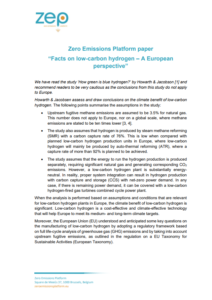ZEP paper: Facts on low-carbon hydrogen – A European perspective
The ZEP Network Technology co-chairs and further experts from the research constituency were engaged in preparing a fact-based, academic paper on low-carbon hydrogen. The ZEP paper provides a realistic picture of blue hydrogen and its role for Europe to reach climate-neutrality.
View the ZEP paper “Facts on low-carbon hydrogen – A European perspective”.
ZEP has read the study “How green is blue hydrogen?” by Howarth & Jacobson and recommends readers to be very cautious as the conclusions from this study do not apply to Europe. Howarth & Jacobsen assess and draw conclusions on the climate benefit of low-carbon hydrogen. The following points summarise the assumptions in the study:
- Upstream fugitive methane emissions are assumed to be 3.5% for natural gas. This number does not apply to Europe, nor on a global scale, where methane emissions are stated to be ten times lower.
- The study also assumes that hydrogen is produced by steam methane reforming (SMR) with a carbon capture rate of 76%. This is low when compared with planned low-carbon hydrogen production units in Europe, where low-carbon hydrogen will mainly be produced by auto-thermal reforming (ATR), where a capture rate of more than 92% is planned to be achieved.
- The study assumes that the energy to run the hydrogen production is produced separately, requiring significant natural gas and generating corresponding CO2 However, a low-carbon hydrogen plant is substantially energy-neutral. In reality, proper system integration can result in hydrogen production with carbon capture and storage (CCS) with net-zero power demand. In any case, if there is remaining power demand, it can be covered with a low-carbon hydrogen-fired gas turbines combined cycle power plant.
When the analysis is performed based on assumptions and conditions that are relevant for low-carbon hydrogen plants in Europe, the climate benefit of low-carbon hydrogen is significant. Low-carbon hydrogen is a cost-effective and climate-effective technology that will help Europe to meet its medium- and long-term climate targets.
Moreover, the European Union understood and anticipated some key questions on the manufacturing of low-carbon hydrogen by adopting a regulatory framework based on full life-cycle analysis of greenhouse gas emissions and by taking into account upstream fugitive emissions, as outlined in the regulation on a EU Taxonomy for Sustainable Activities.

